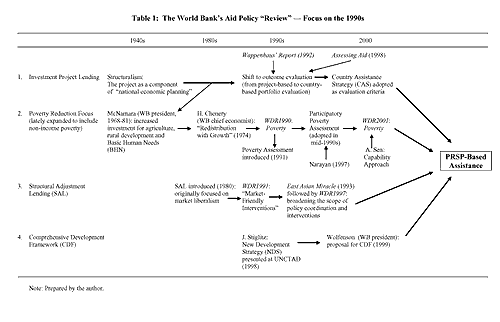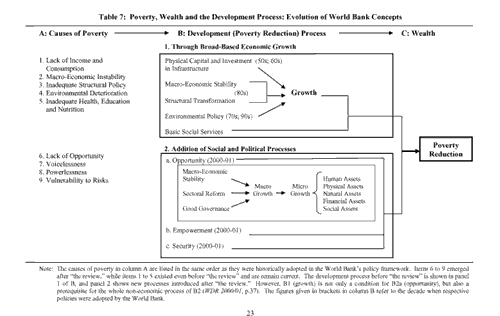 Review of "Growth Promotion versus Poverty Reduction
Review of "Growth Promotion versus Poverty Reduction
--World Bank Rethinking of Aid Policy and Implications for Developing Countries--"
Paper's Author: Shigeru Ishikawa
Emeritus Professor, Hitotsubashi University
| Background |
|
Following the end of the Cold War, the World Bank, in parallel with the IMF, has been engaged in a review of its aid policy. At the end of the 1990s, this "rethinking" led to a radical shift in the declared primary goal of its development strategy from "growth promotion" to "poverty reduction." This goal shift brought with it a new policy framework, accompanied by new procedures and content, namely, the Poverty Reduction Strategy Paper (PRSP). Following the agreement at the IMF/World Bank Annual Meetings in September 1999, the governments of low-income countries seeking concessional financing from the IDA/IMF are now required to formulate PRSP and obtain prior approval from both institutions.
This paper examines the results of the World Bank's rethinking of its development strategy, in terms of the robustness of its new policy framework (so-called the "PRSP-Based Assistance"), and makes specific proposals for its improvements.
|
| Main Points |
- The new development strategy and policy framework are built on a theoretical basis, provided by Joseph Stiglitz and Amartya Sen.
- In terms of policy measures, or action plans to be supported by fiscal resources, the new policy framework lacks robustness. The action plans under the "PRSP-Based Assistance" are incomplete and have not yet passed the test of application in a developing country setting. Moreover, even if these plans were properly formulated, many developing countries (with an underdeveloped system of fiscal management) would find it difficult to compile a reliable budget or expenditure program to support them.
- The goal shift from "growth promotion" to "poverty reduction" is not necessarily driven by the success developing countries have had in fulfilling their aspirations for "economic independence via industrialisation." Therefore, it is too early to conclude that this aspiration has now been completely superseded by a call for poverty eradication.
|
| Proposals for Improving the "PRSP-Based Assistance" |
- There is a need to make the "PRSP-Based Assistance" more complete in terms of policy measures and more applicable to low-income countries with varying development performances.
- It is necessary to identify the appropriate combination of two sets of expenditures for poverty reduction through two approaches, namely, (i) "broad-based growth" expenditures and (ii) "pro-poor targeted" expenditures. While the World Bank advocates a larger allocation for fiscal resources to pro-poor targeted expenditures, some recipients (like Vietnam with better development performances and strong ownership may stress the need for broad-based growth expenditures.)
- It is necessary to determine an optimum combination of the poverty reduction expenditures using the two different approaches, based on the objective and scientific evaluation of a country's economic realities. Their optimum combination is unique for each recipient country as the relative efficacy of poverty reduction expenditures between the two approaches vary by country-specific factors (e.g., GNP growth rate, discount rate, and degree of decentralization in financial management).
- It is necessary to improve the "PRSP-Based Assistance" by conducting detailed, country-specific empirical studies on: (i) the mechanisms that lead to poverty or reduce it; and (ii) the relationship between these mechanisms and individual items of both pro-poor targeted and broad-based growth expenditures. As an example, the paper presents an analysis of the poverty mechanisms at work in the ethnic minorities in the highland regions of Vietnam.
|
| Contents |
|
Executive Summary |
| I. |
Introduction and Overview |
| II. |
Shifting Goals in Aid Policy |
|
II-1. The Policy Review of the 1990s |
|
II-2. Radical Changes in Assistance Program |
| III. |
Does the Goal Shift Mark a Definitive Change? |
| IV. |
Changing Trends in Global Economy |
|
IV-1. End of the Post-War Aspiration to Industrialize? |
|
IV-2. Many Facets of Global Poverty |
| V. |
Stiglitz and Sen--Robustness of Theories |
|
V-1. Stiglitz ad the New Development Strategy (NDS) |
|
V-2. Sen and the Capability Approach |
|
V-3. Famine and Public Action |
| VI. |
Policy Debates at the Conceptual Level |
|
VI-1. A Quiet Debate: The Case of Vietnam |
|
VI-2. Statistical Research Trap |
| VII. |
Search for a New Strategy for Development |
|
VII-1. Pro-Poor Targets and Broad-Based Growth |
|
VII-2. Poverty Mechanisms Affecting the Ethnic Minorities of Upland and Highland Vietnam |
|
|
|
Notes:
(1) This note was written by GRIPS Development Forum, based on Ishikawa's Executive Summary. The entire paper is published as GRIPS Development Forum Discussion Paper No.3 (August 2002).
(2) This Discussion Paper is the English translation of the original text (in Japanese) published in the Transactions of the Japan Academy (Nihon Gakushiin Kiyo), Vol. 56, No.2, January 2002. The author, Shigeru Ishikawa is emeritus Professor of economics, Hitotsubashi University, and was a chairperson of the Japan International Cooperation Agency Study Group on Vietnam. |

